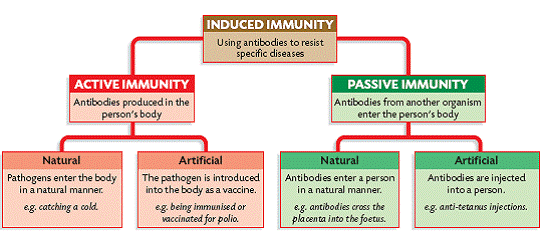FA16 Immunization Module’s Updates
Active versus passive immunity
The immune system is responsible in battling against microbial pathogens which helps to prevent the body from becoming ill. Cells from both the innate and adaptive immune system are important and can work together to ensure that the body remains in good health. However, it is the adaptive immunity that offers protection from specific microbes over the long-term in contrast to innate immunity which is more generalized and acts in the short term. The B cells and T cells of adaptive immunity undergo different levels of maturation and differentiation upon activation. Ultimately, selected B cells can become memory cells which are long-lasting and produce antibodies against specific antigens.
Adaptive immunity can be further divided between active and passive immunity. Active immunity refers to B cell produced antibodies which are a result of the body creating these antibodies through natural infection or also via vaccinations. Although the effectiveness of vaccines depends on different factors, vaccines are designed to create active immunity so that the body can fight off that specific antigen if it is encountered again at a future time.
Passive immunity, however, refers to antibodies that have not been produced by your own body but instead have come from another source. The source of these antibodies may be developed from either another person or from an animal. Passive immunity is sometimes preferred when an immediate response is needed. Therefore, with passive immunity the body can avoid the amount of time it would take for it to make its own antibodies against an antigen. Examples of passive immunity are the maternal antibodies such as IgG passed from mother via the placenta or IgM from breast milk.
Antibodies have been utilized for many decades to combat infectious diseases. For example, antibodies can neutralize toxins in bacterial infections or hinder viral entry into cells in viral infections. Among others, antibodies can help against diphtheria, tetanus, botulism, and assist immunocompromised patients.
Sources:
http://www.cdc.gov/vaccines/pubs/pinkbook/downloads/prinvac.pdf
https://www.ncbi.nlm.nih.gov/pmc/articles/PMC88952/
http://www2a.cdc.gov/nip/isd/ycts/mod1/courses/genrec/10205.asp?student_id=
http://www.viralinfections.info/article/531943799/types-of-immunity-appsc-group-1-mains-p4-s2-unit-5/


